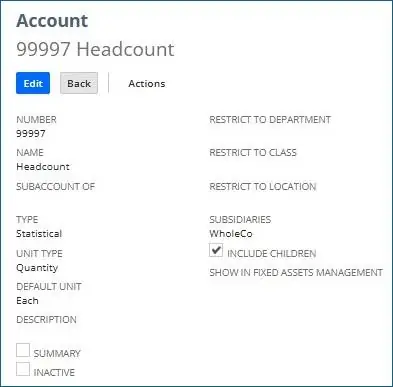Introduction: Why Statistical Accounts Matter
Most NetSuite users are familiar with standard GL accounts, but many overlook a powerful feature included in every environment: statistical accounts. Unlike GL accounts that track currency values, statistical accounts let you store, monitor, and analyze non-financial metrics that drive business performance.
Think about key operational measures like headcount, machine hours, square footage, active subscriptions, or customer visits. While not dollar amounts, these metrics often influence costs, revenue, and profitability. By leveraging statistical accounts, you can integrate these operational KPIs into your NetSuite reporting, financial analysis, allocations, and dashboards, giving your team a data-driven, 360-degree view of performance.
What Are Statistical Accounts?
In NetSuite, a statistical account functions almost exactly like a regular account, except instead of recording dollars and cents, you record numeric quantities. This allows you to measure and analyze activities or resources that have financial impact but are not themselves financial transactions.
- Statistical accounts are created under Setup → Accounting → Accounts → New, with a specific type “Statistical.”
- Select Unit Type
- Select Subsidiary, Department, Location, Class filters.
- You post values to them using Statistical Journals (similar to standard journals).

Common Use Cases
A. Tracking Headcount
Instead of keeping headcount in a spreadsheet, you can use a statistical account to record the number of employees per department or subsidiary each month. This allows you to:
- Calculate “Revenue per Employee” or “Operating Expense per Employee” inside NetSuite reporting.
- Track changes in workforce size alongside financial results, revealing trends like cost per head or productivity shifts.

B. Square Footage for Allocations
If you have multiple offices, warehouses, or retail locations, tracking square footage in statistical accounts enables smarter cost allocations. For example:
- Create an account called “Square Footage by Location.”
- Record the total space for each location once, and maintain it when changes occur.
- Use this account in Allocation Schedules to fairly distribute rent, utilities, or maintenance costs based on actual space used.
This ensures overhead expenses are allocated equitably rather than on arbitrary percentages.
C. Machine Hours
Manufacturing organizations can leverage statistical accounts to track machine hours at the work center level.
- Post machine usage hours monthly.
- Allocate overhead costs based on actual usage instead of evenly spreading costs.
- Build KPIs like “Throughput per Machine Hour” to evaluate efficiency.
This brings operational reality into financial reporting, helping managers pinpoint bottlenecks or underutilization.
D. Other Creative Uses
Statistical accounts are flexible. Some additional examples include:
- Tracking website traffic or e-commerce orders to compare against marketing spend.
- Recording customer support cases for metrics like “Cost per Case.”
- Monitoring miles driven for fleet management and fuel cost analysis.
- Capturing number of active subscriptions for SaaS companies, then calculating revenue per subscription.
How to Set Up & Use Statistical Accounts
1: Create a Statistical Account
- Navigate to Lists → Accounting → Accounts → New
- Select Type: Statistical
- Enter the name, and assign subsidiary, department, class, or location as needed.
- Consider naming conventions like “Headcount – By Department” for clarity.
2: Record Activity with Statistical Journals
- Go to Transactions → Financial → Make Statistical Journal Entries.
- Post values to the relevant statistical accounts each month.
- Example: record 125 employees in Sales and 75 in Operations for September.
3: Tie to Allocation Schedules
- Navigate to Transactions → Financial → Create Allocation Schedules.
- Create an allocation schedule using the relevant statistical account.
- Example: distribute $20,000 of building maintenance and repair expenses proportionally based on the headcount of each department recorded in the statistical accounts.
Allocation Schedule Header:
- Provide a meaningful name for the schedule.
- Select the subsidiary for the schedule.
- Frequency. For our example, we are using the End of the Period.
- Next Date: Select the next Journal Entry date to be generated from the schedule.
- Weighted Source: Select the Statistical Account you want to use for allocation.
- Date Basis: For our example, we are using Period to Date.
- Unit Type: This is based on the unit type of the Statistical Account selected.
- Allocation Mode: Static or Dynamic Allocation. Dynamic Allocation allows us to use the statistical values to generate contribution rates by department in our example.

Allocation Schedule Source:
Select the Account you wish to source the transactions from to be allocated across your statistical journal values.
You can further filter to a single entity so that only expenses related to that vendor are considered for allocation.

Allocation Schedule Destination:
Here you will select the following for allocation:
- Target Account
- Target Department
- Location if applicable
- Class if Applicable.
- Sample Weight will display the allocation rate of the expenses for each entry based on the values in the statistical journal account for the period. You can click on Update Sample Weights to regenerate the rates as you enter each line.

Once you save the allocation schedule, you may manually generate the Journal Entry by clicking on the Create Journal Entry button at the top of the Allocation Schedule screen.

This will generate the Journal with the expenses allocated across your departments for the period.

Reporting & Dashboards
- Use Saved Searches, Reports, or SuiteAnalytics Workbooks to combine financial and statistical data.
- Examples:
- Revenue ÷ Headcount = productivity ratio.
- Rent ÷ Square Footage = cost per square foot.
- Support Tickets ÷ Active Subscriptions = support intensity.
- Add statistical KPIs to dashboards so CFOs, controllers, and operations managers can monitor them regularly.
Best Practices
- Update Regularly: Post statistical journals on a monthly cadence as part of your close process. Stale or missing data reduces usefulness.
- Segment Thoughtfully: Create accounts by department, subsidiary, or location if you want granular allocation or reporting.
- Automate When Possible: Use CSV imports, SuiteScript, or integrations to pull headcount, hours, or activity automatically from source systems.
- Validate & Audit: Periodically reconcile statistical accounts against source data (e.g., HR roster, facility lease docs, production logs).
- Communicate Usage: Make sure controllers, FP&A teams, and department heads understand how these accounts drive allocations and KPIs.
Conclusion
Statistical accounts are a hidden gem in NetSuite, standard, powerful, and flexible. By leveraging them to track headcount, square footage, machine hours, active subscriptions, or other operational drivers, you can:
- Improve allocation accuracy across departments, projects, and cost centers.
- Connect operational metrics to financial performance for smarter decision-making.
- Unlock actionable KPIs and real-time business insights without additional modules or third-party tools.
Maximize your NetSuite reporting, analytics, and performance management by incorporating statistical accounts into your workflow.
About Us
We are NetSuite Solutions Providers with 30+ years of combined experience. We specialize in implementation, optimization, integration, rapid project recovery & rescues, and custom development to meet any business need. Although every business is unique, serving over 40 NetSuite clients during the last 6 years, our NetSuite Consulting team has most likely seen your challenge and created similar solutions. For more information on NetSuite solutions or questions about your project contact usHere.

